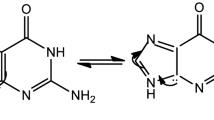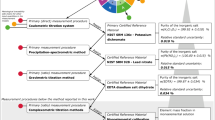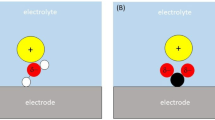Abstract
The stability constants for the hydrolysis of Cu(II) and formation of chloride complexes in NaClO4 solution, at 25 °C, have been examined using the Pitzer equations. The calculated activity coefficients of CuOH+, Cu(OH)2, Cu2(OH)3+, Cu2(OH) 2+2 , CuCl+ and CuCl2 have been used to determine the Pitzer parameter (β (0) i , β (1) i , and C i ) for these complexes. These parameters yield values for the hydrolysis constants (log 10 β *1 , log 10 β *2 , log 10 β *2,1 and log 10 β *2,2 ) and the formation of the chloride complexes (log 10 β *CuCl and \(\log_{10}\beta_{\mathrm{CuCl}_{2}}^{\mathrm{*}})\) that agree with the experimental measurements, respectively to ±0.01,±0.02,±0.03,±0.06,±0.03 and ±0.07.
The stability constants for the hydrolysis and chloride complexes of Cu(II) were found to be related to those of other divalent metals over a wide range of ionic strength. This has allowed us to use the calculated Pitzer parameters for copper complexes to model the stability constants and activity coefficients of hydroxide and chloride complexes of other divalent metals. The applicability of the Pitzer Cu(II) model to the ionic strength dependence of hydrolysis of zinc and cadmium is presented. The resulting thermodynamic hydroxide and chloride constants for zinc are \(\log_{10}\beta_{\mathrm{ZnOH}^{+}}=-9.04\pm0.04\) and \(\log_{10}\beta_{\mathrm{Zn(OH)}_{2}}=-16.90\pm0.02\) . For cadmium the thermodynamic hydrolysis constants are \(\log_{10}\beta_{\mathrm{CdOH}^{+}}=-10.24\pm0.05\) and \(\log_{10}\beta_{\mathrm{Cd(OH)}_{2}}=-20.42\pm0.07\) . The Cu(II) model allows one to determine the stability of other divalent metal complexes over a wide range of concentration when little experimental data are available. More reliable stepwise stability constants for divalent metals are needed to test the linearity found for the chloro complexes.
Similar content being viewed by others
References
Campbell, P.G.C.: Interactions between trace metals and aquatic organisms: a critique of the free-ion activity model. In: Tessier, A., Turner, D.R. (eds.) Metal Speciation and Bioavailability in Aquatic Systems. Wiley, New York (1995)
Sunda, W., Guillard, R.R.L.: The relationship between cupric ion activity and the toxicity of copper to phytoplankton. J. Mar. Res. 134, 511–529 (1976)
Morel, F.M.M., Morel-Laurens, N.M.L.: Trace metals and plankton in the oceans. Facts and speculations. In: Wong, C.S., Boyle, E., Bruland, K.W., Burton, J.D., Goldberg, E.D. (eds.) Trace Metals in Sea Water. NATO Conference Series IV, Marine Sciences, pp. 841–869. Plenum Press, New York (1983)
Brand, L.E., Sunda, W.G., Guillard, R.R.L.: Reduction of marine phytoplankton reproduction rates by copper and cadmium. J. Exp. Mar. Biol. Ecol. 96, 225–250 (1986)
Verweij, W.: Speciation and bioavailability of copper in lake Tjeukemeer. Ph.D. thesis, University of Wageningen, The Netherlands (1991), 143 pp
Blust, R., Fontaine, A., Declair, W.: Effect of hydrogen ions and inorganic complexing on the uptake of copper by the brine shrimp Artemia franciscana. Mar. Ecol. Prog. Ser. 76, 273–282 (1991)
Seritti, A., Pellegrini, D., Morelli, E., Barghigiani, C., Ferrara, R.: Copper complexing capacity of phytoplanktonic cell exudates. Mar. Chem. 18, 351–357 (1986)
Brown, L.N., Robinson, M.G., Hall, B.D.: Mechanisms for copper tolerance in Amhora coffeaeformis—internal and external binding. Mar. Biol. 97, 581–586 (1988)
Zhou, X., Slauenwhite, D.E., Pett, R.J., Wangersky, P.J.: Production of copper-complexing organic ligands during a diatom bloom: tower tank and batch-culture experiments. Mar. Chem. 27, 19–30 (1989)
Zhou, X., Wangersky, P.J.: Production of copper-complexing organic ligands by the marine diatom Phaeodactylum triconutum in a cage culture turbidostat. Mar. Chem. 26, 239–259 (1989)
Gonzalez-Davila, M., Santana-Casiano, J.M., Laglera, L.M.: Copper adsorption in diatom cultures. Mar. Chem. 70, 161–170 (2000)
Moffett, J.W., Zika, R.G.: Oxidation kinetics of Cu(I) in seawater: implications for its existence in the marine environment. Mar. Chem. 13, 239–251 (1983)
Moffett, J.W., Zika, R.G.: Reduction kinetics of hydrogen peroxide with copper and iron in seawater. Environ. Sci. Technol. 21, 804–810 (1987)
Zafiriou, O.C.: Marine organic photochemistry previewed. Mar. Chem. 5, 497–522 (1977)
Zika, R.G.: Marine organic photochemistry. In: Duursma, E.K., Dawson, R. (eds.) Marine Organic Chemistry, pp. 299–325. Elsevier, Amsterdam (1981)
Millero, F.J.: The effect of ionic interactions on the oxidation of metals in natural waters. Geochim. Cosmochim. Acta 49, 547–553 (1985)
Sharma, V.K., Millero, F.J.: Effect of ionic interactions on the rates of oxidation of Cu(I) with O2 in natural waters. Mar. Chem. 25, 141–161 (1988)
Pitzer, K.S.: Activity Coefficients in Electrolyte Solutions, pp. 75–153. CRC Press, Boca Raton (1991)
Powell, K.J., Brown, P.L., Byrne, B.H., Gajda, T., Hefter, G., Sjöberg, S., Wanner, H.: Chemical speciation of environmentally significant metals with inorganic ligands. Part 2: The Cu2+-OH−, Cl−, SO 2−4 , and PO 3−4 systems. Pure Appl. Chem. 79, 895–950 (2007)
Millero, F.J., Pierrot, D.: A chemical equilibrium model for natural waters. Aquat. Geochem. 4, 153–199 (1998)
Kim, H.-T., Frederick, W.J.: Evaluation of Pitzer ion interaction parameters of aqueous electrolytes at 25 °C. 1. Single salt parameters. J. Chem. Eng. Data 33, 177–184 (1988)
Møller, N.: The prediction of mineral solubilities in natural waters: a chemical equilibrium model for the Na-Ca-Cl-SO4-H2O system, to high temperature and concentration. Geochim. Cosmochim. Acta 52, 821–837 (1988)
Baes, C.F., Mesmer, R.E.: The Hydrolysis of Cations, pp. 267–272. Wiley-Interscience, New York (1976)
Millero, F.J.: Use of models to determine ionic interactions in natural waters. Thalass. Jugosl. 18, 253–291 (1982)
Millero, F.J., Schreiber, D.R.: Use of the pairing model to estimate activity coefficients of the ionic components of natural waters. Am. J. Sci. 282, 1508–1540 (1982)
Millero, F.J., Hawke, D.J.: Ionic interactions of divalent metals in natural waters. Mar. Chem. 40, 19–48 (1992)
Millero, F.J.: Stability constants for the formation of rare earth inorganic complexes as a function of ionic strength. Geochim. Cosmochim. Acta 56, 3123–3132 (1992)
Smith, R.M., Martell, A.E.: Critical Stability Constants, Vol. 4, Inorganic Complexes, p. 257. Plenum Press, New York (1976)
Author information
Authors and Affiliations
Corresponding author
Rights and permissions
About this article
Cite this article
Santana-Casiano, J.M., González-Dávila, M. & Millero, F.J. The Examination of the Activity Coefficients of Cu(II) Complexes with OH− and Cl− in NaClO4 Using Pitzer Equations: Application to Other Divalent Cations. J Solution Chem 37, 749–762 (2008). https://doi.org/10.1007/s10953-008-9274-2
Received:
Accepted:
Published:
Issue Date:
DOI: https://doi.org/10.1007/s10953-008-9274-2




